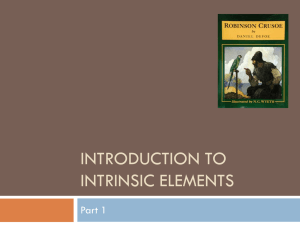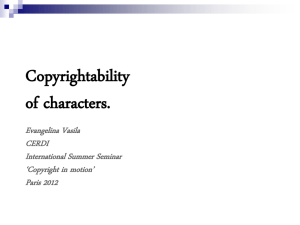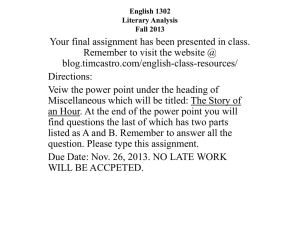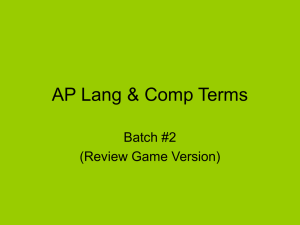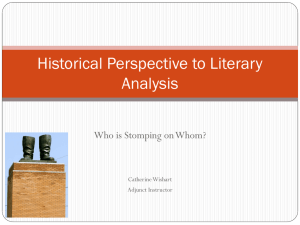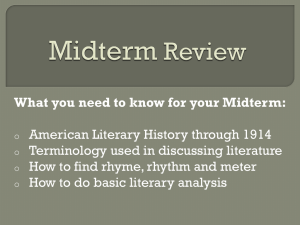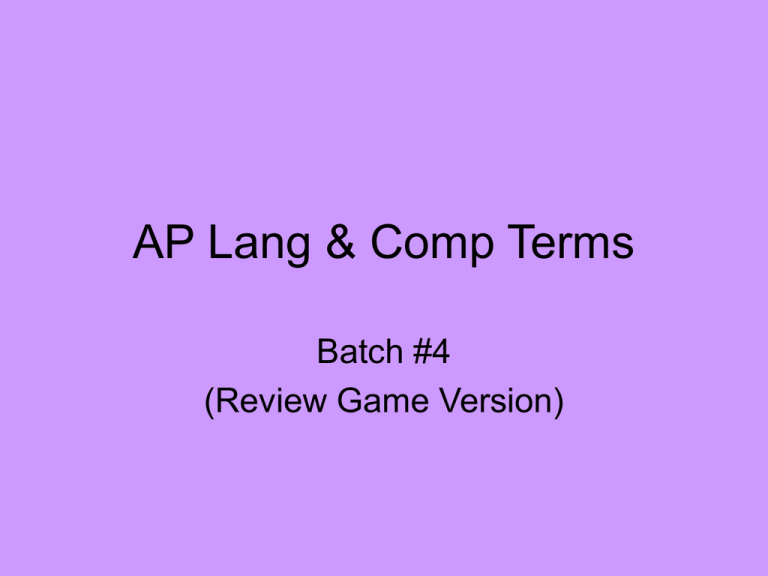
AP Lang & Comp Terms
Batch #4
(Review Game Version)
#1
Identify the literary device/term:
Words that connect ideas and show the
relationships between those ideas
(relationships such as causal links,
similarities, contrasts, and so on)
Answer #1
Transition words
#2
Identify the literary device being used:
I got hives from the shrimp I ate last night.
I must be allergic to shellfish.
Answer #2
Inductive reasoning
• Reasoning in which one arrives at a
general conclusion from specific
instances.
#3
Identify the literary device/term:
A story
Answer #3
narrative
#4
Identify the literary device/term:
To turn or move away from the main subject
of discussion or the main argument in a
piece of writing.
Answer #4
Digression
#5
Identify the literary device/term:
Following the established rules or
conventions of writing
Answer #5
Formal writing
#6
Identify the literary device being used:
Walt Whitman’s poem “O Captain, My
Captain” was written upon the death of
Abraham Lincoln
Answer #6
Apostrophe
A direct address to an absent or dead
person, or to an object, quality, or idea
#7
Identify the literary device being used:
In “Ode to Melancholy,” John Keats
describes a “weeping cloud.”
Answer #7
Personification pathetic fallacy
The attribution of human feeling or
motivation to a nonhuman object,
especially an object found in nature
#8
The following are examples
James Boswell’s Life of Samuel Johnson
Plato’s The Death of Socrates
George Kent’s A Life of Gwendolyn Brooks
Answer #8
Biography
The nonfictional story of an individual’s life
written by someone else
#9
Identify the literary device being used:
Chicken is supposed to be healthy.
This sandwich contains chicken.
So, it is probably healthy.
Answer #9
Deductive reasoning
Reasoning in which one derives a specific
conclusion from something generally or
universally understood to be true.
#10
Identify the literary device being used:
“Life imitates art far more than art imitates life.”
(Oscar Wilde, “The Decay of Lying”)
Answer #10
Chiasmus
Two phrases in which the syntax is the same but
placement of words is reversed.
(BTW…this quote is also an example of aphorism)
#11
Identify the literary device/term:
The mode of reasoning by which we
determine whether something is valid or
invalid, according to which any claim
should (in principle) be able to be justified
by reasons and evidence.
Answer #11
Logic
#12
Identify the literary device/term:
An exaggeration of fact
(also: hyperbole)
Answer #12
Overstatement
#13
Identify the literary device/term:
Form of narration in which the narrator
conveys a subject’s thoughts, impressions,
and perceptions exactly as they occur,
often in disjointed fashion and without the
logic and grammar of typical speech and
writing
Answer #13
Stream-of-consciousness
#14
Identify the literary device/term:
The narrator of a poem; also the voice
assumed by the writer (not necessarily the
author him/herself).
Answer #14
Speaker
#15
Identify the literary device/term:
A technique in which one understanding of a
situation stands in sharp contrast to
another, usually more prevalent,
understanding of the same situation.
Answer #15
Situational irony
#16
Identify the literary device/term:
In writing and literature, an author’s
exaggeration or distortion of certain traits
or characteristics of an individual.
Answer #16
Caricature
#17
Identify the literary device/term:
A novel about the education or psychological
growth of the protagonist, or main
character.
Answer #17
Bildungsroman
#18
Identify the literary device being used:
In the poem “Chicago,” Carl Sandburg
describes the city as a “stormy, husky,
brawling, /City of the Big Shoulders.”
Answer #18
Personification pathetic fallacy
The attribution of human feeling or
motivation to a nonhuman object,
especially an object found in nature
#19
Identify the literary device being used:
“The wine-dark sea”
(Homer, The Iliad)
Answer #19
Epithet
An adjective or phrase that describes a
prominent or distinguishing feature of a
person or thing
#20
Identify the literary device being used:
As hot as the sun
Answer #20
Simile
A comparison of two unlike things through
the use of like or as
#21
Identify the literary device being used:
When the going gets tough,
the tough get going.
Answer #21
Chiasmus
Two phrases in which the syntax is the same
but placement of words is reversed.
#22
Identify the literary device being used:
Avoid it like the plague.
Answer #22
Cliché
An expression that has been used so
frequently it has lost its expressive power
(BTW…also an example of simile)
#23
The following is an example of what
sentence structure?
Just when you think it’s safe to go in the
water, a shark bites you.
Answer #23
Delayed (periodic) sentence
A sentence that delays introducing the
subject and verb (or independent clause)
until the end.
#24
Identify the literary device being used:
“What lies behind us and what lies before us
are tiny compared to what lies within us.”
(Ralph Waldo Emerson)
Answer #24
Epistrophe
The repetition of a word or group of words at
the end of successive phrases, clauses,
verses, or sentence.
#25
Identify the literary device being used:
Saying “making love” instead of “having sex”
Answer #25
Euphemism
The use of more pleasant language to
express unpleasant or vulgar ideas,
events, or actions.



